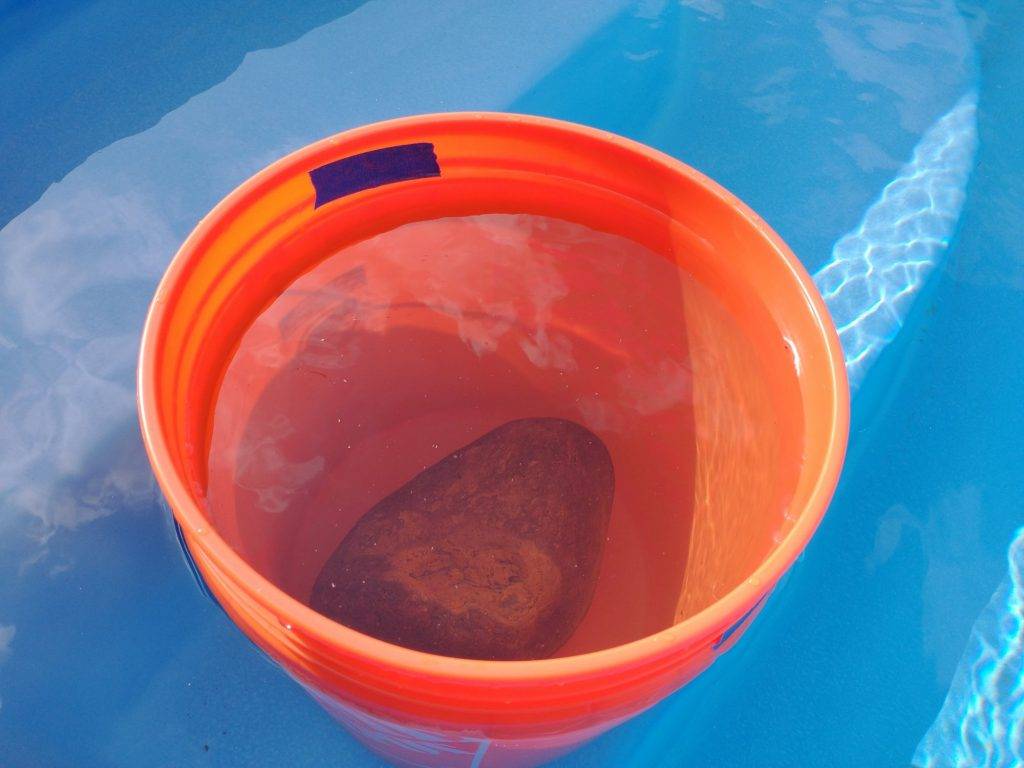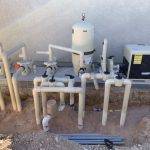It’s a sad truth, but owning a pool sometimes means having a leak. We understand that fear when we think the water level is dropping too fast. Another indication you may have a leak is soggy ground or the unexplained loss of CYA, CH, or salt levels. Leaks can originate either in the pool itself or in the plumbing and filtration system. Leaks generally come in two types – air or water. Air leaks draw air into the plumbing system (suction-side air leak) and usually result in excessive air bubbles in the system, often seen in the pump strainer pot or return jets. More about suction side air leaks can be found HERE. Water leaks however allow water to seep out of the pool, either from the vessel or plumbing. For the purpose of this page, we’ll focus on those water leaks and address both the pool vessel (shell) and plumbing possibilities. This should help you identify which kind of leak you have and help with your leak detection. Then you can create your own post/thread here on the forum to get better responses one the next step to stop your pool from losing water.
Is my pool leaking?
Let’s start with the easy stuff first. Some water leaks are found above ground at the equipment pad where you can see the water coming out of a connection. Some filters use a multiport valve which can leak water to WASTE without you knowing it (i.e. bad spider gasket). But if you can see the leak, we can tell you how to fix it. If you can’t see any drips around the filter system or equipment pad, then we can help you figure out if the leak is in the pool or plumbing.
So you still suspect a leak huh? Let’s show you a simple test to help with your detection of a leak. It’s called the BUCKET TEST. Homeowners use the BUCKET TEST as a convenient way to see if there is a leak or significant water loss. This method can be performed with the pump on or off depending on what you are evaluating (shell or plumbing). The BUCKET TEST can be performed a couple ways, and we have a few tips to help make it as accurate as possible. In either case, if you have an auto-fill, ensure it is OFF.
Probably the most simple method of leak detection is done by marking water levels on a bucket with tape or a marker. To do this, use any general purpose bucket and fill it fairly close to the top with pool water. If the water level in the bucket is too low, wind won’t impact water in the bucket the same way it does in the pool, so results may vary. Then place the bucket in the pool on the steps or whatever shelf you may have available so that a majority of the bucket is submerged. This helps to keep the bucket water temperate close to the pool water temperature.
The bucket may try to float-up on you. If it does, you can place a brick or heavy/large stone in the bucket to help weight it down. Once the bucket is in place, the two water lines (pool and bucket levels) will probably not be the same height. Simply mark the waterlines with a marker or tape on the inside and outside of the bucket to show the starting points and monitor the water level changes for 24 hours. If the outside (pool) waterline drops significantly more than the inside bucket water level, your pool is losing water due to a leak.
The other method eliminates the tape and marker by using a bucket that is transparent so you can see waterlines from either side. Try placing an empty transparent bucket on the steps or shelf in the pool water. You’ll have to hold it down for now. You should clearly see the pool water level through the inside of the bucket. Now with a cup, begin filling the transparent bucket with pool water to match the pool waterline.
Remember you want the waterlines fairly close to the top of the bucket if possible so that the impact of wind on the water will be the same as in the pool. Like the other method, you can add a brick or a heavy stone to the bucket to help hold it down. Once the two waterlines are the same, you monitor it for 24 hours. Keep in mind that if you have a fairly large pool, say 15K or more, a 1-inch drop in pool water can equate to several hundred gallons of water.
Finding a leak in your pool
So now you’ve confirmed your pool is losing water, but where? With the exception of an above ground leak, water leaks generally occur in one of two areas – either within the pool vessel itself (i.e. liner, gunite, or the shell), or in the plumbing buried underground. At this point you want to isolate the shell from the plumbing. Plug all the inlets and outlets (returns, skimmers, drains, cleaner lines). If you have an auto-fill, ensure it is OFF. Mark the water level with a piece of tape or a pencil and monitor to see how much the water level drops in 24 hours with the pump OFF. Remember that heat and wind play major roles in water loss, so try to pick a time when the wind won’t impact your results too much if possible.
In the summer, it’s reasonable to lose 1/8 – 1/4 inch of water per day to evaporation and wind. If the pool is losing water with the lines plugged, the vessel (shell) itself is somehow compromised. Either the liner has a tear, a crack in the gunite/shell, or there is a leak at a connection/fitting point. You’ll want to check areas such as inside the light niche, around the skimmer, or perhaps suction/return fittings. If you have a main drain, there might be water loss around the drain area itself. Drain hydrostatic plugs/valves can also become defective and result in water loss. To help with leak detection in any of these areas, you can use some food coloring/dye to check for a leak.

A syringe is a good tool to help pinpoint where your pool is losing water. You’ll carefully inject dye around a fitting. If the dye gets sucked “in” to a fitting or crack, you found a leak. Another rule of thumb – the leak is where the water stops dropping (i.e. skimmer, return jets, pool light, or tear in the liner, etc). If you elect to let the water level drop to find a leak, be cautious if the leak is in the lower portion of the pool.
If you live in an area with a high groundwater table, upwards pressure can disrupt your pool shell. Some pools not only rely on the water pressure to keep it pressed down, but also to keep the liner firmly in place and walls upright (as applicable). So if the leak is suspected to be at the bottom of the pool, consider all options ahead of time before letting the water level get too low.
Underground Leak Detection
If the pool itself doesn’t show any loss of water with the lines plugged, the problem is most likely in the underground plumbing. But where? Suction side or pressure side? If the break is on the suction side (skimmer or drain to pump), water can leak “out” of that pipe with the pump OFF. If the leak is on the pressure side (after the filter towards the return jets), water can leak “out” when the pump is ON or OFF.
To isolate either side for evaluation, you can use rubber (winterizing) plugs to close-off and isolate certain ports/lines. You may also see signs of a pressure-side leak in the yard if the ground is soggy or sunken. At this point you can either dig yourself if you believe you know where a potential leak might be, or call a leak detection company. These companies have the tools and methods to pinpoint an underground leak within a few inches. Often this is done by using pressured air/water coupled with sonar, sound plates, and scopes to find a leak.
A pool leak can be stressful, but if you follow what’s been said here and post your findings on the forum, we should be able to get you in the right direction. We have lots of experienced members on the forum that can help. If you have a question, start a new thread/discussion about your issue and we’ll do our best to help. Good luck!








